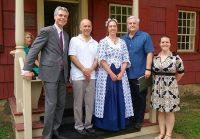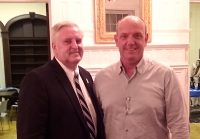White Plains Visited by Alexander Hamilton Direct Descendant
 With a Broadway production about Alexander Hamilton making it big and bringing attention to one of our country’s most notorious founding fathers, White Plains became a focal point this past weekend of an historic tour.
With a Broadway production about Alexander Hamilton making it big and bringing attention to one of our country’s most notorious founding fathers, White Plains became a focal point this past weekend of an historic tour.
A direct descendant of Alexander Hamilton visited the historic Purdy House and the White Plains Public Library Sunday to view a mural depicting Alexander Hamilton’s part in the Battle of White Plains.
The event was part of “Hamilton on the Hudson” an annual festival sponsored by the Alexander Hamilton Awareness Society (AHA), to educate about Hamilton’s extensive presence in the Hudson River Valley of New York. The first Hamilton on the Hudson program was held in July 2013 in the mid-Hudson Valley to commemorate the 225th anniversary of New York ratifying the U.S. Constitution.
Douglas Hamilton, a five times great grandson of Alexander Hamilton, made the stops in White Plains, accompanied by members of the White Plains Historical Society.
Hamilton was personally greeted and escorted by Mayor Tom Roach to Battle of White Plains Memorial Park and the library to see the “Hamilton at the Cannon” mural.

Members of the White Plains Historical Society were also invited to an event Saturday evening at the Nevis Mansion in Irvington where they met Douglas Hamilton and another Hamilton direct descendant, Alan Key.
Key is a descendant of Alexander Hamilton’s son, John Hamilton who built Nevis Mansion in Irvington in 1835 and named it for the Island of Nevis, his father’s birthplace. The mansion and 68-acre grounds are now part of Columbia University, and is their Physics Research Laboratory site.
According to the Bronx River Alliance website, “The summer of 1776 had been a disastrous season for the American Revolution. George Washington had lost the battle of Brooklyn in August, was forced to abandon New York City in September, and by late October he was marching his tattered army northward along the west bank of the Bronx River to avoid being trapped on Manhattan Island by British forces that had landed around New Rochelle.”
“White Plains was a crossroads town commanding one of the few bridges over the Bronx River (or “Brunks” River as the maps of the day called it). White Plains also held a depot of desperately needed supplies.”
“Reaching White Plains ahead of the British, the Americans dug in along a line of hills just north of present-day Main Street, determined to hold on long enough to ensure that the slow-moving supply wagons were safely north on the road to Peekskill. Almost as an afterthought Washington posted several regiments on the crest of Chatterton Hill, which sharply rose along the west bank of the Bronx River, and from which they could threaten the flank of the British if they attacked the American main line. Ordered by Washington to “do the best you can,” the Americans fortified the place as best they could with cornstalks and awaited the enemy while Alexander Hamilton placed his two-gun battery in a commanding position near the hill’s highest point.”
“Though termed inconclusive by many historians, the battle of White Plains had several outcomes. It marked the failure of the last opportunity to trap Washington and end the Revolution, and it marked the arrival of the Hessians as a significant fighting force. White Plains also helped make the careers of three people: Alexander Hamilton, who distinguished himself as a young artillery captain; Johann Rall, whose initiative as a Hessian commander that day eventually gained him the command of a place called Trenton on the Delaware River; and the Headless Horseman, the nameless Hessian who lost his head at Chatterton Hill, and who legend has it went on to haunt Sleepy Hollow.”
Alexander Hamilton went on to become a Founding Father of the United States, chief staff aide to General George Washington, one of the most influential interpreters and promoters of the U.S. Constitution, the founder of the nation’s financial system, the founder of the Federalist Party (the world’s first voter-based political party), the founder of the United States Coast Guard, and the founder of The New York Post newspaper.
As the first Secretary of the Treasury, Hamilton was the primary author of the economic policies of the George Washington administration. Hamilton took the lead in the funding of the states’ debts by the Federal government, the establishment of a national bank, a system of tariffs, and friendly trade relations with Britain. He led the Federalist Party, created largely in support of his views; he was opposed by the Democratic-Republican Party led by Thomas Jefferson and James Madison, which despised Britain and feared that Hamilton’s policies of a strong central government would weaken the American commitment to Republicanism.

